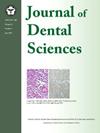水平位错对正面、斜位和侧位面微笑测量变化的影响
IF 3.1
3区 医学
Q1 DENTISTRY, ORAL SURGERY & MEDICINE
引用次数: 0
摘要
背景/目的水平骨骼差异可以影响微笑美学,但它们对不同摄影视角下微笑动态的影响仍未得到充分研究。本研究的目的是评估水平错牙合如何影响软组织的变化,在正面,斜,侧面微笑视图。材料与方法回顾性分析200例患者治疗前面部照片。根据ANB角度和复喷值将受试者分为亚组。微笑特征是在休息时和微笑时从正面、倾斜和侧面观察来测量的。变量表示为相对于鼻下-颏下距离的比率。统计学比较采用方差分析、scheff本文章由计算机程序翻译,如有差异,请以英文原文为准。
Effects of horizontal dimensional malocclusion on changes in smile measurements in frontal, oblique, and lateral views
Background/purpose
Horizontal skeletal discrepancies can influence smile esthetics, but their impact on smile dynamics from different photographic perspectives remains underexplored. This study aimed to evaluate how horizontal malocclusion affects soft tissue changes in frontal, oblique, and lateral smile views.
Materials and methods
This retrospective study analyzed pre-treatment facial photographs of 200 patients. Subjects were divided into subgroups based on ANB angle and overjet values. Smile characteristics were measured from frontal, oblique, and lateral views at rest and during smiling. Variables were expressed as ratios relative to subnasale-menton distance. Statistical comparisons were made using ANOVA, Scheffé post hoc tests, and multiple regression analysis.
Results
Significant differences in smile measurements were more prominent in the oblique and lateral views than in the frontal view. Among ANB groups, greater discrepancies were noted in lower facial landmarks such as menton and pogonion. Oblique views were most sensitive in detecting differences in smile change, particularly among subjects with Class III malocclusion.
Conclusion
Horizontal dimensional malocclusion significantly affects soft tissue smile dynamics, particularly in the oblique view. Multiview smile analysis enhances diagnostic accuracy and should be considered in orthodontic assessment and treatment planning.
求助全文
通过发布文献求助,成功后即可免费获取论文全文。
去求助
来源期刊

Journal of Dental Sciences
医学-牙科与口腔外科
CiteScore
5.10
自引率
14.30%
发文量
348
审稿时长
6 days
期刊介绍:
he Journal of Dental Sciences (JDS), published quarterly, is the official and open access publication of the Association for Dental Sciences of the Republic of China (ADS-ROC). The precedent journal of the JDS is the Chinese Dental Journal (CDJ) which had already been covered by MEDLINE in 1988. As the CDJ continued to prove its importance in the region, the ADS-ROC decided to move to the international community by publishing an English journal. Hence, the birth of the JDS in 2006. The JDS is indexed in the SCI Expanded since 2008. It is also indexed in Scopus, and EMCare, ScienceDirect, SIIC Data Bases.
The topics covered by the JDS include all fields of basic and clinical dentistry. Some manuscripts focusing on the study of certain endemic diseases such as dental caries and periodontal diseases in particular regions of any country as well as oral pre-cancers, oral cancers, and oral submucous fibrosis related to betel nut chewing habit are also considered for publication. Besides, the JDS also publishes articles about the efficacy of a new treatment modality on oral verrucous hyperplasia or early oral squamous cell carcinoma.
 求助内容:
求助内容: 应助结果提醒方式:
应助结果提醒方式:


